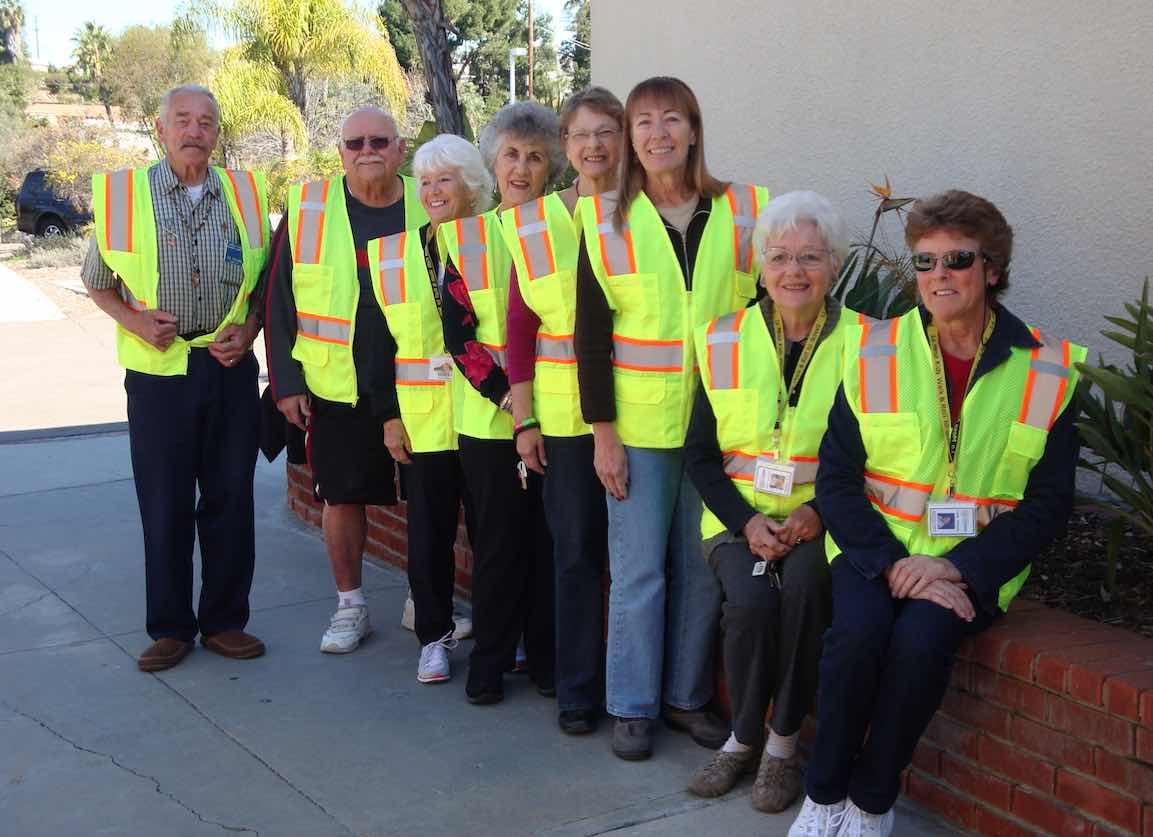La Mesa’s Seniors Help With Safe Routes to School
The City of La Mesa won the Cities Counties Schools Partnership Intergovernmental Collaboration Award in the 2015 Helen Putnam Award for Excellence program. For more about the award program, visit www.helenputnam.org. For more about the Cities Counties Schools Partnership, visit www.ca-ilg.org/ccs-partnership.
Located in the rolling hills of San Diego County, the City of La Mesa (pop. 58,000) is a community of tree-lined streets and walkable neighborhoods. A significant challenge facing La Mesa is the need to increase residents’ regular physical activity as part of an effort to address high levels of obesity and other health-related problems that are linked to the increasingly sedentary lifestyles of children and older adults.
Program Gets People Moving
Statistics from San Diego County’s Live Well San Diego Community Health Improvement Plan show that the La Mesa region has one of the highest obesity rates in the county with an average of 67 percent of adults overweight. The national average is 35 percent.
In 1969 approximately 50 percent of children nationwide walked or bicycled to school, according to the Safe Routes to School National Partnership. Today, fewer than 15 percent of children do so, and rates of childhood obesity are alarming. Additionally, La Mesa has one of the highest concentrations of older adults in the region, and lack of physical activity and social engagement can lead to more sedentary lifestyles and increased likelihood of falls and other injuries in this population. Furthermore, according to parent surveys completed at La Mesa schools in April 2014, concerns about traffic safety and lack of adult supervision are reasons that parents do not allow children to walk or bicycle to school.
“Our greatest challenge was how to address these issues with limited staffing and available funding,” says La Mesa Mayor Mark Arapostathis. “We partnered with our schools, the county, businesses and our residents.”
The County of San Diego Health and Human Services Agency’s Aging and Independence Services, La Mesa-Spring Valley School District, MetLife and Circulate San Diego (a nonprofit transportation advocacy organization) joined La Mesa to develop and implement the Intergenerational Safe Routes to School (SRTS) program in 2011.
The program’s partners leveraged scarce funding and enhanced marketing and advertising to recruit volunteers. The partnership created job descriptions based on the unique characteristics and needs of each school and recruited volunteers for the program, starting with three pilot schools.
Program Benefits Volunteers, Youth and Community
The city expanded its existing SRTS program and recruited adults age 50 and older to provide supervision and support to students as they walk or bike to and from school. Encouraging older adults to volunteer addresses a critical safety need for students and gives volunteers an opportunity for regular physical activity and social interaction.
“As a retired person, it’s too easy to just sit on the couch all day in front of the TV,” says volunteer Ed Clavell. “Volunteering with this program gives me a reason to get up early every morning and stay productive throughout the day.”
“La Mesa was one of the county’s first Live Well San Diego partners, working to improve the health and safety of all those living in our region,” says Ellen Schmeding, director of the county’s Aging and Independence Services. “Children and their parents have a deeper sense of comfort knowing there are ‘eyes and ears’ on the road to ensure the journey to and from school is good. The volunteers thrive when helping strengthen their community with this important service.”
Measuring the Results
Parents report that they are more comfortable letting their children walk or bike to school because adults are present along the route. Students feel safer and become familiar with older adults who live in their neighborhood. Volunteers benefit from regular physical activity and increased socialization with students, parents and staff as well as other volunteers.
Statistics compiled before, during and after program implementation show increased walking and biking to school year to year. Most importantly, the three pilot schools in this program showed the highest attendance during International Walk to School Day, with a 12 percent average increase. Today, nine schools participate in La Mesa’s Intergenerational SRTS program. Overall:
- 75 percent of schools increased rates of students walking to school; and
- 38 percent of schools increased rates of students bicycling to school.
“From the district’s perspective, the program promotes an overall healthy and safe lifestyle,” says Brian Marshall, superintendent of the La Mesa-Spring Valley School District.
Volunteers have contributed 368 hours to the Intergenerational SRTS program since fall 2015. When asked what they gained from the program, volunteers named benefits including:
- “Knowing I am playing a part in maintaining safety for children, and interacting with children and parents is fun;” and
- “The program has positively impacted my social contact and communication, increased my physical activity and given me tremendous emotional satisfaction.”
Toolkit Offers Help
La Mesa developed a toolkit to ensure the program’s sustainability and aid in replicating the program. Five other cities have replicated the Intergenerational SRTS program with grant funding provided through the county’s Aging and Independence Services. Many other cities in California have referenced the toolkit, La Mesa Safe Routes Guide — Intergenerational Volunteer Program, in crafting programs for their communities. The toolkit is available at www.cityoflamesa.com/SRTS.
Contact: Misty Thompson, safe routes coordinator, City of La Mesa; phone: (619) 667-1319; email: mthompson@ci.la-mesa.ca.us.
Photo credit: Courtesy of City of La Mesa and League of California Cities
This article appears in the March 2016 issue of Western City
Did you like what you read here? Subscribe
to Western City


